Physical Address
304 North Cardinal St.
Dorchester Center, MA 02124
The morphology, type of exudate, and principally affected areas help define the etiology of conjunctivitis.
Chronicity plays a key role in classifying conjunctivitis.
Acute conjunctivitis is typically infectious in etiology.
Masquerade syndromes must be considered in cases of chronic conjunctivitis.
The conjunctiva is a thin, translucent mucous membrane whose palpebral portion lines the posterior surface of the eyelids and whose bulbar portion lines the anterior surface of the globe. The conjunctiva is firmly adherent to the lids over the tarsal plates and loosely attached in the fornices and over the globe, with the exception of the limbus.
As with other mucous membranes, the conjunctiva has an epithelial layer and a submucosal substantia propria. The conjunctival epithelium is contiguous with the corneal epithelium and also lines the lacrimal passages and glands, a fact that has significant clinical implications. The substantia propria is composed of a superficial adenoid layer and a deeper fibrous layer. The adenoid layer contains lymphoid tissue from which follicles are formed. Within the lymphoid tissue are germinal centers with lymphoblasts in the center. The fibrous layer is composed of connective tissue, which attaches to the tarsal plate and contributes to the characteristic appearance of papillae.
The formation of papillae is a nonspecific sign of conjunctival inflammation resulting from edema and polymorphonuclear (PMN) cell infiltration of the conjunctiva. Papillae can form only where the conjunctiva is attached to the underlying tissue by anchoring septae, such as over the tarsus or the bulbar limbus. Fibroblasts, macrophages, mast cells, and PMNs are found extravascularly within the substantia propria. Mast cells (5000 mm 3 ) and plasma cells are normally present in the substantia propria, but not in the conjunctival epithelium. Neutrophils and lymphocytes (100,000 mm 3 ) are routinely found in both conjunctival epithelium and substantia propria, whereas basophils and eosinophils are not normally present in either conjunctival epithelium or substantia propria. ,
The conjunctival vessels are derived from the anterior ciliary and palpebral arteries. Conjunctival injection is characterized by superficial bright red blood vessels, which are most conspicuous in the fornices and fade toward the corneoscleral limbus. These vessels move as the conjunctiva is mechanically manipulated and are blanched by topical instillation of phenylephrine.
Conjunctival hyperemia is secondary to dilation of the conjunctival blood vessels without accompanying exudation or cellular infiltration. Hyperemia is distinct from conjunctivitis and may be caused by a multiplicity of environmental factors including smoke, smog, or chemical fumes, wind, ultraviolet radiation, and prolonged topical instillation of vasoconstrictors.
Conjunctivitis implies inflammation of the conjunctiva and is characterized by cellular infiltration and exudation in addition to vascular dilation. Chemosis, an accumulation of fluid within or beneath the conjunctiva, is frequently present. The patient may complain of eyelid fullness and a diffuse, gritty foreign body sensation. Frequently, patients may notice a discharge that causes the eyelids to stick together. The condition may be unilateral or bilateral.
The diagnosis of conjunctivitis may be based on one or more of the following: (1) the history and clinical examination; (2) Gram and Giemsa stains of conjunctival scrapings; (3) culture and identification of conjunctival scrapings; (4) conjunctival biopsy; and (5) immunoassay, polymerase chain reaction (PCR), or other viral diagnostic tests. Patient history can be helpful. Infectious disease is often bilateral and may involve other members of the family or community. Most cases of acute viral conjunctivitis initially involve one eye, followed a few days later by involvement of the other eye. The presence of an enlarged preauricular lymph node suggests a viral etiology. Unilateral involvement may suggest a toxic, pharmacologic, mechanical, or lacrimal origin.
Several diagnostic criteria are helpful in determining the underlying etiology of conjunctivitis. Chronicity plays an important role and is the most widely used criterion for classification of conjunctivitis. An acute conjunctivitis is arbitrarily defined as having a duration of less than 3 weeks, whereas chronic conjunctivitis has a longer duration of symptoms. , The morphologic appearance, type of exudate, and principally affected areas of the conjunctiva are the other most important physical findings that help define the etiology of conjunctivitis.
In addition to the chronicity of conjunctivitis, five morphologic responses can be identified that help define algorithms for acute or chronic conjunctivitis ( Figs. 36.1 and 36.2 ): papillary, follicular, membranous/pseudomembranous, cicatrizing, granulomatous. Proper identification of the morphologic response is crucial to the correct diagnosis.
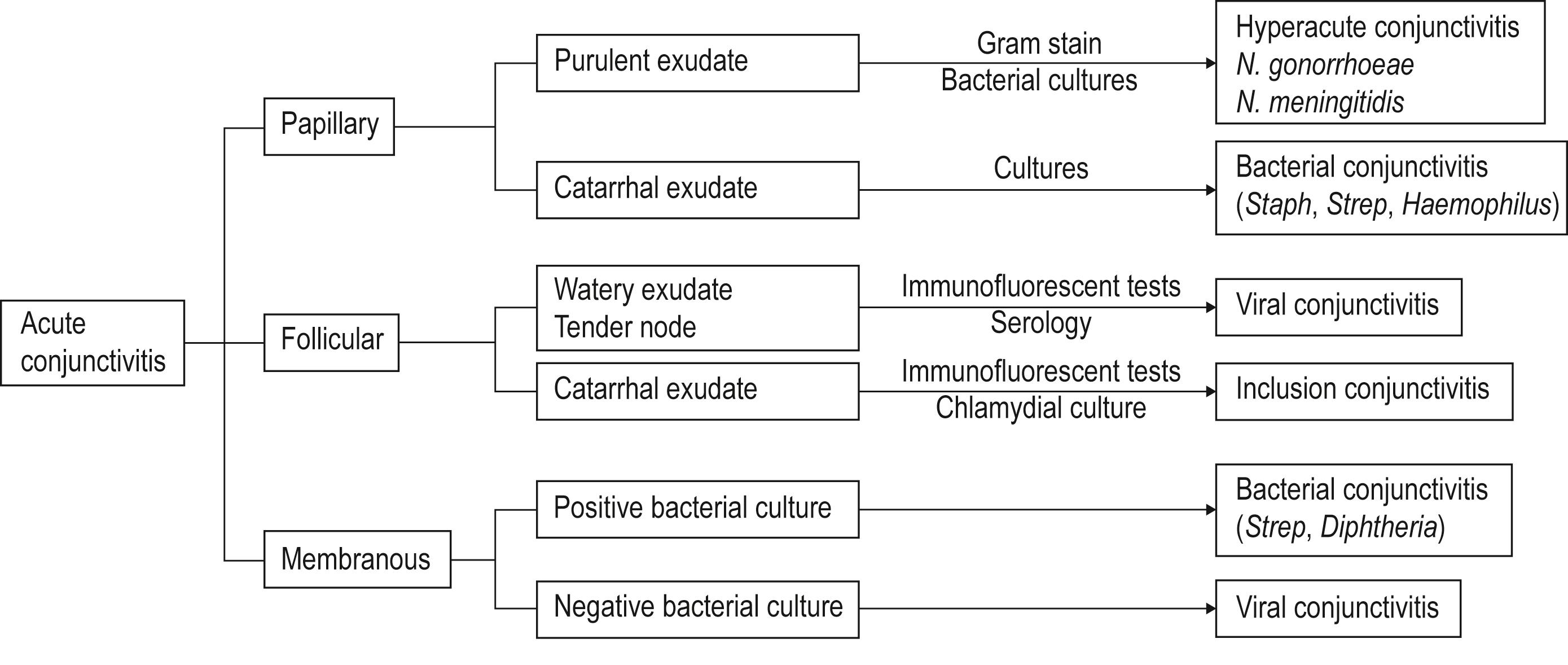
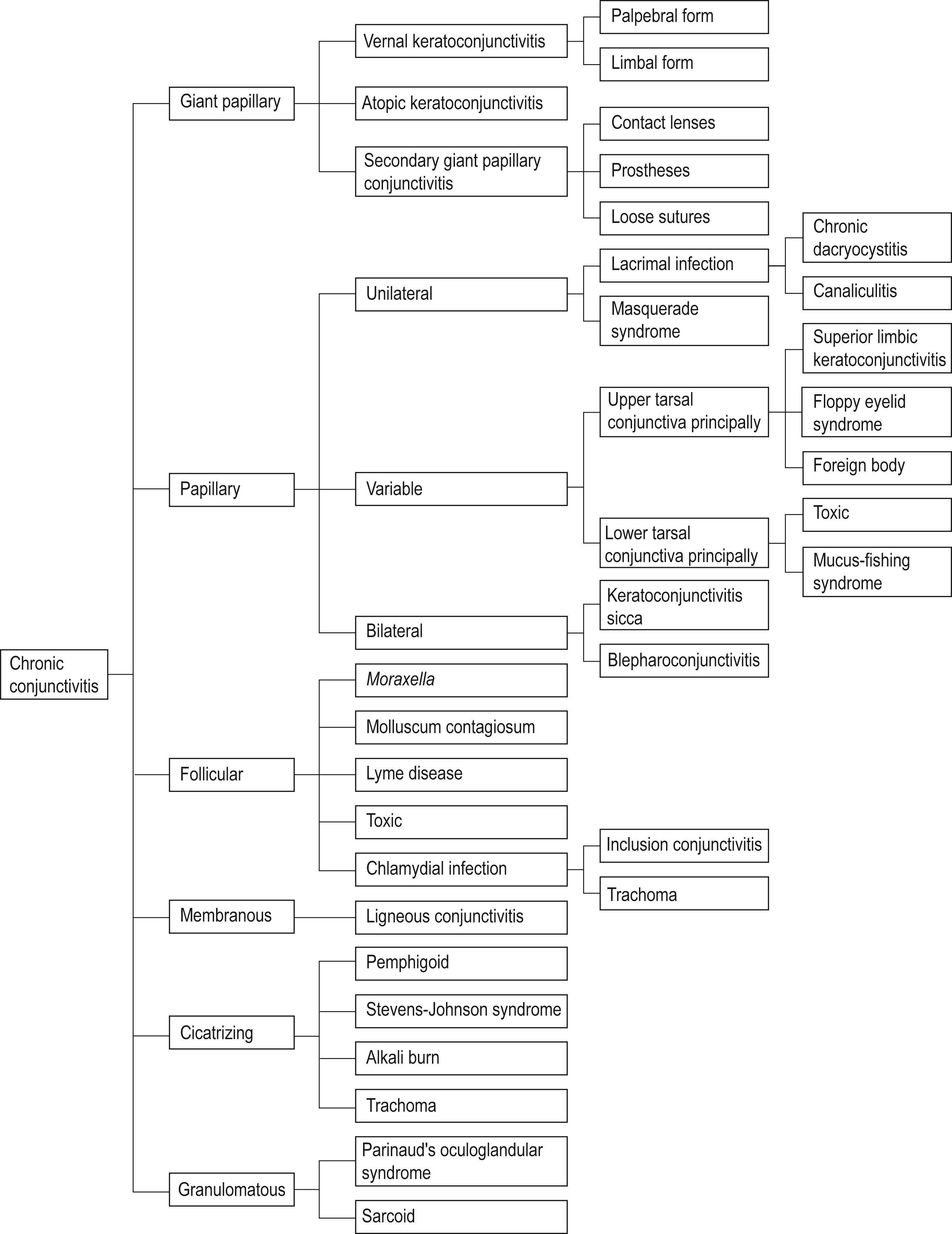
Papillae are found only where the conjunctiva is attached to the underlying tissue by anchoring septae. The anchoring septae normally divide the conjunctiva into a mosaic pattern of polygonal papillae, each less than 1 mm in diameter. Papillae are characterized by folds or projections of hypertrophic epithelium that contain a central fibrovascular core whose blood vessels arborize on reaching the surface ( Fig. 36.3 ). A papillary response is a nonspecific sign of conjunctival inflammation resulting from edema and PMN cell infiltration of the conjunctiva. Papillae in the tarsal conjunctiva tend to be flat-topped, whereas those at the limbus tend to be dome-shaped. When the upper tarsal conjunctiva is everted, the superior edge may contain large papillae, which may be a normal finding resulting from the paucity of anchoring septae in this area.
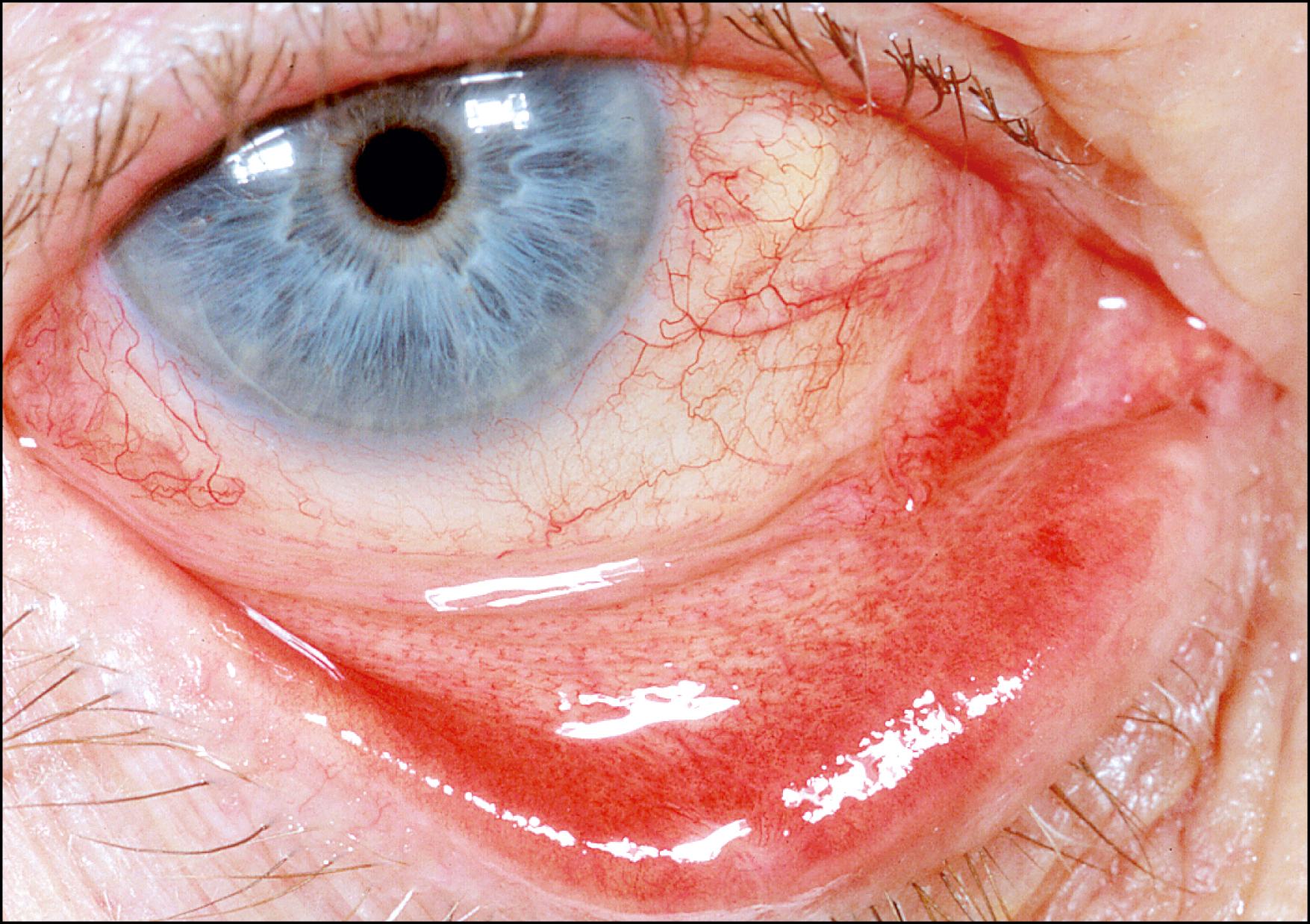
Giant papillae may develop from breakdown of the fine, fibrous strands that make up the anchoring septae. Giant papillae are greater than 1 mm in diameter and are most commonly found in the upper tarsal conjunctiva. They can be seen in vernal conjunctivitis, atopic keratoconjunctivitis (AKC), and as a foreign body reaction to suture material, contact lenses, or prostheses.
Follicles are yellowish-white, discrete, round elevations of conjunctiva produced by a lymphocytic response. Unlike a papilla, the central portion of the follicle is avascular, with blood vessels sweeping up over the convexity from the base ( Fig. 36.4 ). Follicles are most readily appreciated in the upper tarsal conjunctiva and the lower cul-de-sac; however, they also can be seen at the limbus. Follicles are typically 0.5–2.0 mm in diameter, although follicles larger than 2 mm in diameter are seen, particularly in chlamydial disease. Follicles are lymphoid germinal centers with fibroblasts in the center, and may be seen in the normal conjunctiva, especially temporally in young patients. Folliculosis of childhood is not a disease entity but a physiologic change of childhood and adolescence in which follicles tend to be prominent in the fornix and fade out toward the lid margin. A follicular response is extremely important to identify because it is a relatively specific inflammatory response with a well-defined differential diagnosis ( Box 36.1 ).
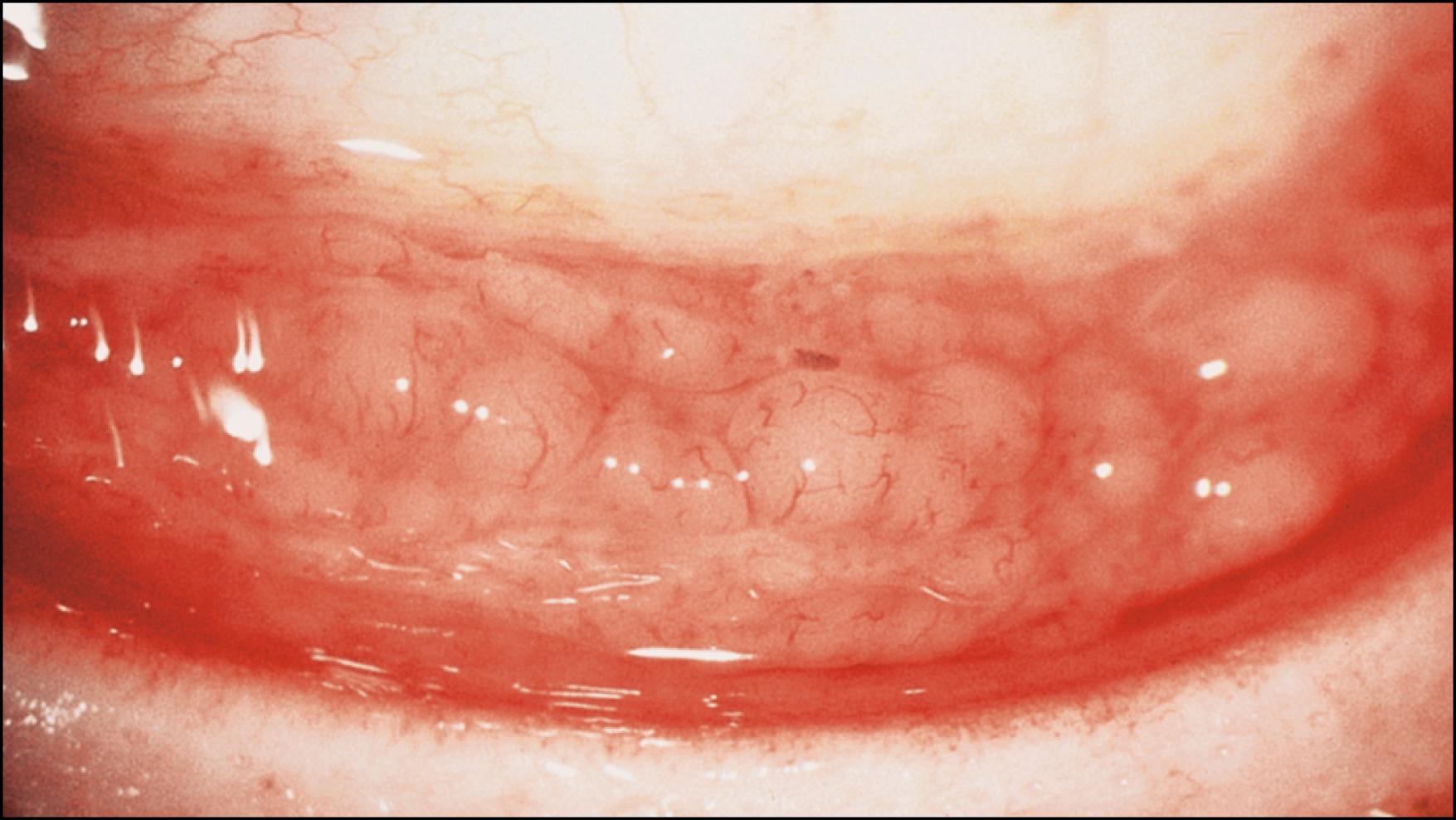
Acute follicular conjunctivitis
Adenovirus
Epidemic keratoconjunctivitis
Pharyngeal conjunctival fever
Acute, nonspecific follicular conjunctivitis
Inclusion conjunctivitis
Herpesviruses
Herpes simplex (primary)
Epstein-Barr virus
Paramyxoviruses (measles, mumps, Newcastle disease)
Poxviruses (smallpox, vaccinia and monkeypox)
Picornaviruses (acute hemorrhagic conjunctivitis)
Orthomyxoviruses (influenza)
Togaviruses (rubella, yellow fever, dengue, and sandfly fever)
Chronic follicular conjunctivitis
Chlamydial infections
Trachoma
Inclusion conjunctivitis
Molluscum contagiosum
Moraxella
Parinaud oculoglandular syndrome
Lyme disease
Toxic conjunctivitis
Folliculosis
Membranes are composed primarily of fibrin that has attached to the epithelial conjunctival surface. True membranes leave a raw surface and cause bleeding when peeled off, which differentiates them from pseudomembranes. However, the distinction between the two really reflects the degree of the inflammatory response, as true membranes signify more intense conjunctival inflammation. Historically, Corynebacterium diphtheriae and β-hemolytic streptococci were the principal causes of membranous/pseudomembranous conjunctivitis ; however, adenoviral conjunctivitis is now the most common cause in Western countries ( Fig. 36.5 ), followed by primary herpes simplex virus (HSV) conjunctivitis. , Other causes include vernal conjunctivitis, inclusion conjunctivitis, and Candida . Stevens-Johnson syndrome (SJS) and toxic epidermal necrolysis (TEN) affect mucous membranes and skin. Bilateral pseudomembranous conjunctivitis is common in these conditions and may lead to severe conjunctival scarring, loss of goblet cells, entropion, trichiasis, and limbal stem cell failure.
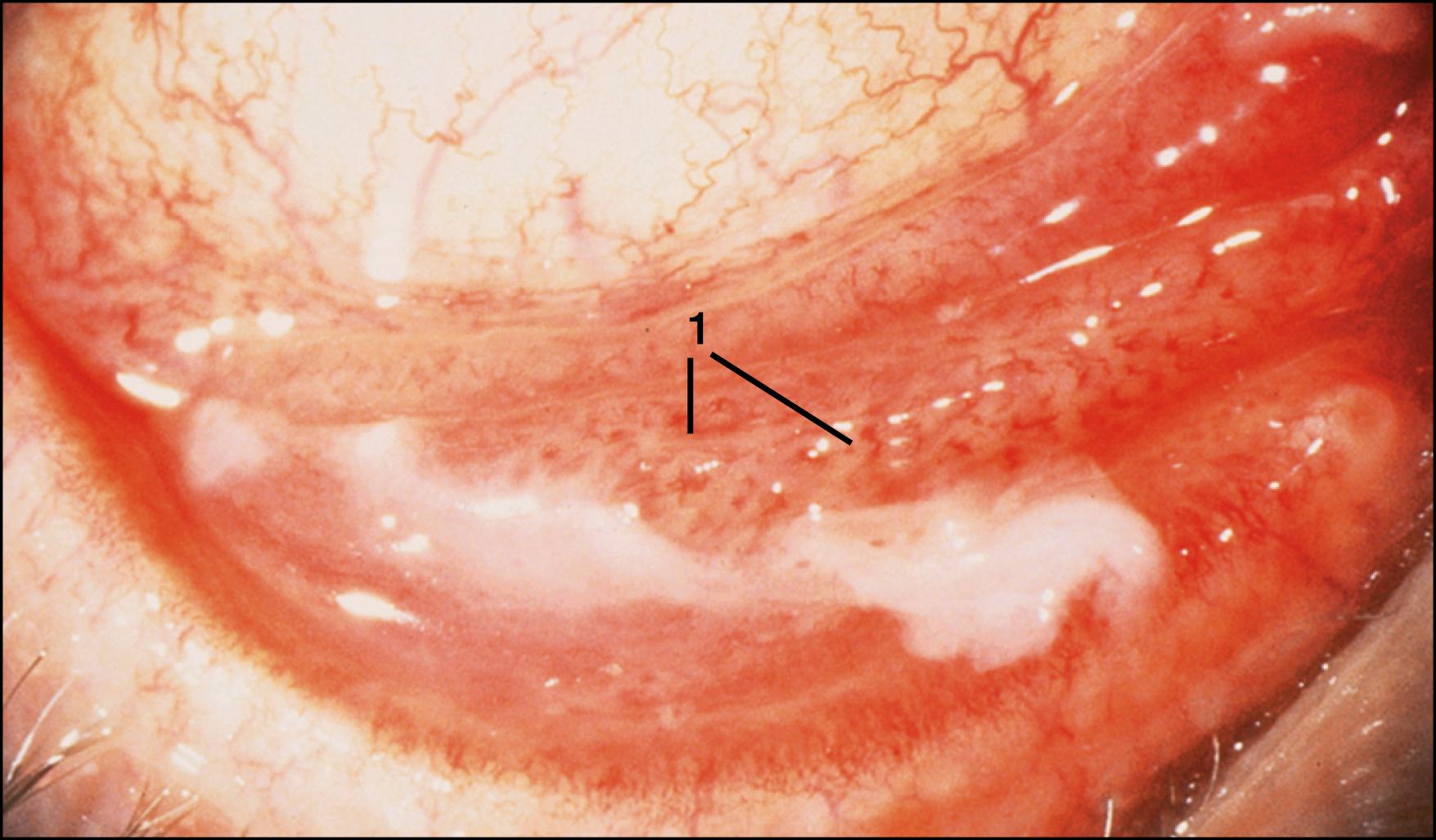
Injury to the conjunctival epithelium does not provoke scar formation. Scar formation ensues only when there is destruction of stromal tissue. The early stages of cicatrization consist of foreshortening of the conjunctival fornix and stellate or linear, lacey, subepithelial fibrosis. Subconjunctival cicatrization and scarring may have long-standing complications, including cicatricial entropion and trichiasis. If the process continues, foreshortening of the conjunctival fornix worsens and symblepharon develop ( Fig. 36.6 ). End stages of chronic cicatrizing disease as seen in ocular mucous membrane pemphigoid (OMMP) include obliteration of the conjunctival fornix, keratinization of the epithelium, and fusion of the eyelids known as ankyloblepharon.
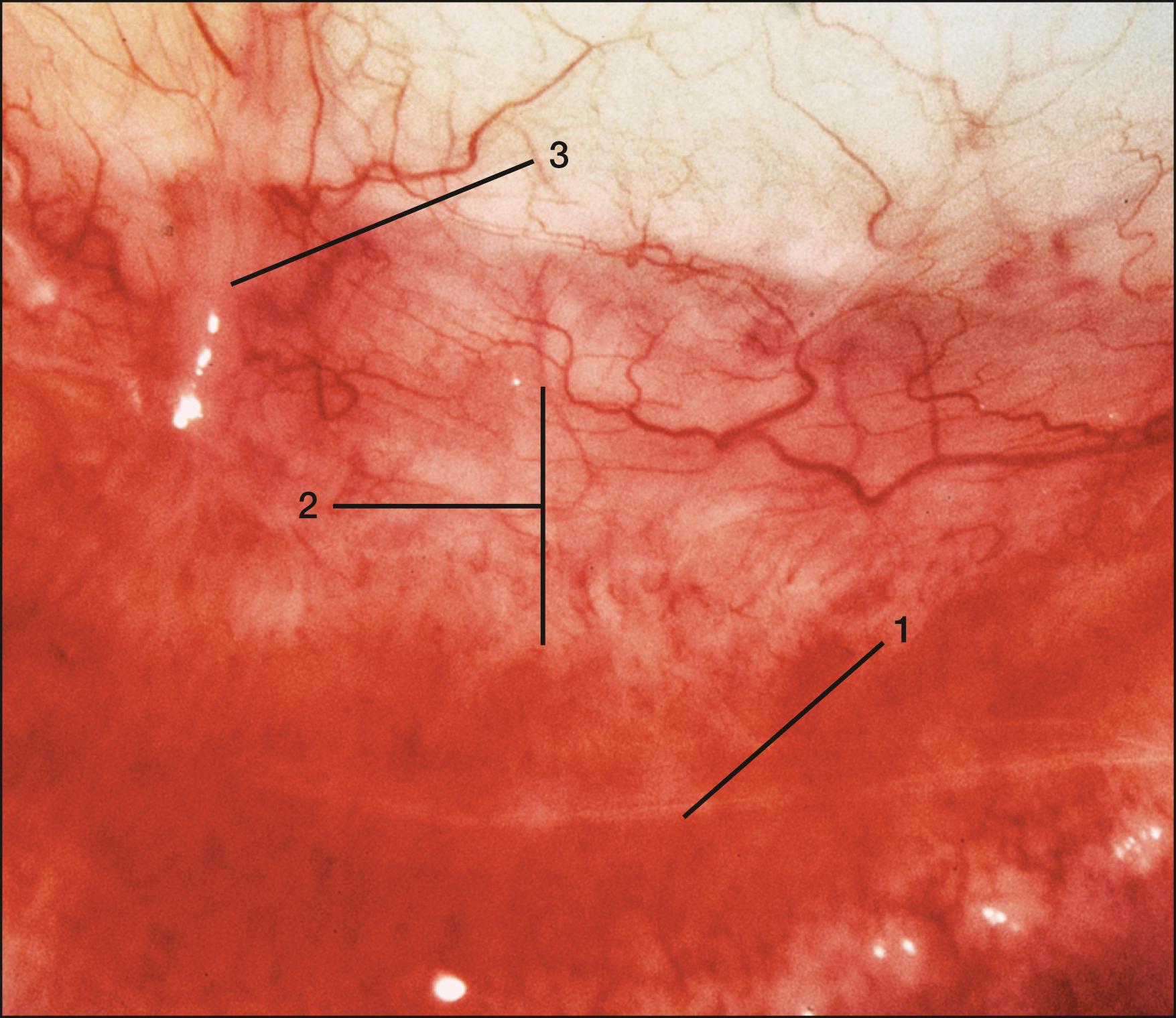
Membranous conjunctivitis is generally an acute condition, but may result in subepithelial fibrosis and limited symblepharon formation. Scarring after membranous conjunctivitis shows no predilection for any portion of the conjunctiva.
Scarring from AKC tends to be focal and located in the centers of giant papillae. Diffuse shrinkage of the lower fornix may be seen, but entropion and trichiasis tend not to occur.
Scarring from trachoma is quite specific. The pathognomonic sign is the cicatricial remains of a limbal follicle known as the Herbert peripheral pit. A line of cicatricial subepithelial fibrosis may be seen near the superior border of the upper tarsus known as the Arlt line. , Arlt line may be seen in other diseases, but is an important finding in trachoma. The disease process in trachoma always involves the upper lid more severely than the lower lid. Dermatitis herpetiformis, epidermolysis bullosa, SJS, and TEN, and exfoliative dermatitis also may result in conjunctival scarring.
Conjunctival granulomas always affect the stroma. A conjunctival granuloma may be seen in sarcoidosis or from a retained foreign body. Parinaud oculoglandular syndrome is a unilateral granulomatous conjunctivitis ( Fig. 36.7 ) with a localized follicular response, often associated with a visibly swollen preauricular or submandibular lymph node. Fever and other systemic signs may be present. A variety of infectious agents may cause this syndrome, including cat-scratch disease, tularemia, sporotrichosis, tuberculosis, syphilis, lymphogranuloma venereum, and rickettsiosis. A biopsy may be required to establish the diagnosis.
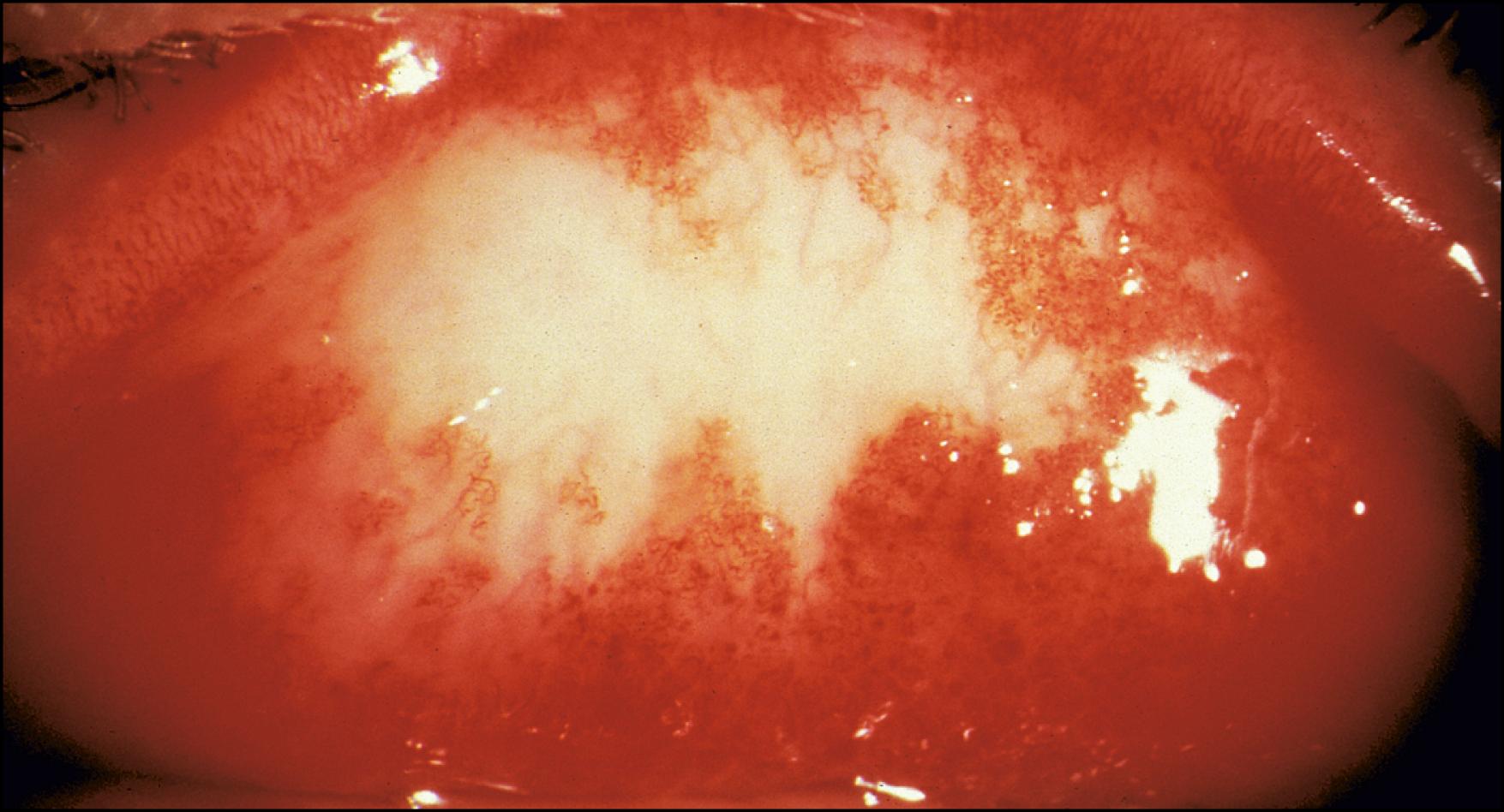
Conjunctival exudates may be classified as: (1) purulent or hyperacute; (2) mucopurulent or catarrhal; and (3) watery. , , Hyperacute conjunctivitis has a rapidly progressive course, with grossly purulent discharge. When the discharge is irrigated from the eye, it tends to re-form in minutes. A mucopurulent or catarrhal discharge consists of a mixture of mucus and pus and is most commonly seen in bacterial or chlamydial conjunctivitis. A mucopurulent discharge adheres firmly to the lashes, causing the eyelids to stick together. A copious, watery discharge is more typical of viral conjunctivitis.
The most severely affected area of the conjunctiva can be helpful in determining a differential diagnosis. Trachoma affects the upper tarsus more severely than the lower tarsus. Follicles also may be seen at the upper limbus in trachoma. Other disorders involving the upper palpebral conjunctiva predominantly include superior limbic keratoconjunctivitis, floppy eyelid syndrome, and giant fornix syndrome.
Vernal keratoconjunctivitis (VKC) is a chronic, allergic conjunctival inflammation with seasonal exacerbations, particularly in the spring and early summer. Giant papillae may be seen on the upper pretarsal conjunctiva. In black patients, the papillae have predilection for the limbus. In AKC, giant papillary hypertrophy not only predominates in the upper lid, but also can be seen in the lower lid. In contrast to symptoms of VKC, symptoms of AKC may be present throughout the year. The chronicity of AKC may lead to corneal vascularization and scarring and, in some cases, conjunctival cicatrization.
Giant papillae also may be seen secondarily on the upper tarsus in contact lens wearers, patients wearing prostheses, or from exposed suture material. Secondary giant papillae may be difficult to differentiate from follicles, as they tend to have rounder apices, are more spherical, and have pale centers. However, in follicular conjunctivitis both the upper and lower palpebral conjunctivae are affected, whereas in secondary giant papillary conjunctivitis (GPC), only the upper palpebral conjunctiva is typically affected.
Conditions principally affecting the lower tarsal conjunctiva include toxic papillary conjunctivitis and the “mucus-fishing syndrome.” The follicular response in inclusion conjunctivitis is more pronounced inferiorly than superiorly.
The morphologic response and type of exudate are the most important considerations in acute conjunctivitis. Acute papillary conjunctivitis is nearly always bacterial. Hyperacute conjunctivitis is most likely caused by Neisseria gonorrhoeae or Neisseria meningitidis and is characterized by a rapidly progressive course with grossly purulent discharge. Corneal ulceration with resultant scarring is the major cause of visual loss and can lead to corneal perforation. With the exception of neonatal conjunctivitis, gonococcal conjunctivitis is nearly always associated with genital infection where transmission occurs by autoinoculation from the patient’s dominant hand. Gonococcal conjunctivitis is more common than meningococcal conjunctivitis, but the two are clinically indistinguishable. Systemic dissemination, including septicemia, can occur with either organism. Gram stain of conjunctival scrapings should be carefully examined for the presence of intracellular gram-negative diplococci. Specific identification of the organism can be established by culture and sugar fermentation tests. Antimicrobial susceptibility studies are essential because of the emergence of resistant strains of Neisseria to penicillin.
Treatment of hyperacute conjunctivitis includes frequent saline lavage of the corneas, topical antibiotic, and parenteral antibiotics. Public health screening of sexual contacts is mandatory when N. gonorrhoeae is identified. If N. meningitidis is isolated, close contacts must be treated with prophylactic antibiotics.
Acute papillary conjunctivitis with a catarrhal or mucopurulent exudate characterizes the majority of cases of bacterial conjunctivitis. One or both eyes may be involved, and the onset is acute. Signs include papillary hypertrophy, conjunctival injection, a mucopurulent discharge, and crusting of the eyelashes. The cornea may be involved by a secondary punctate epitheliopathy that may affect vision. Staphylococcus aureus , Haemophilus influenzae , and streptococci are the most frequently isolated organisms. , , Cytologic examination using Giemsa or Wright stain reveals a preponderance of PMNs in bacterial conjunctival infections. A specific diagnosis can be established only by performing conjunctival cultures. Broad-spectrum topical antibiotic therapy, in general, results in rapid resolution.
Acute follicular conjunctivitis has a well-defined differential diagnosis that includes viral infections and the early phase of chlamydial inclusion conjunctivitis. Papillae may be seen in addition to follicles, since papillae simply represent a nonspecific response of conjunctival tissue to any acute or chronic inflammatory condition.
Adenovirus is responsible for the majority of cases of acute viral conjunctivitis. Adenoviral infection may present as epidemic keratoconjunctivitis (EKC), pharyngeal conjunctival fever, or nonspecific follicular conjunctivitis. EKC is a highly contagious infection principally caused by adenovirus serotypes 8 and 19. Transmission commonly occurs by direct contact. Clinical symptoms are seen approximately 8 days after exposure. Symptoms of EKC include a sudden onset of an acute, watery discharge associated with foreign body sensation, and mild photophobia. The infection generally involves first one eye and the second eye a few days later, which typically has a milder course. Preauricular node enlargement and tenderness is common and is more prominent on the side initially involved. The distinguishing feature of EKC is the pattern of corneal involvement.
A few days after the onset of conjunctivitis, diffuse punctate epithelial erosions develop on the cornea. These coalesce into larger, coarse, epithelial infiltrates 7–10 days after onset. Approximately 2 weeks after onset, the coarse, epithelial infiltrates are replaced by focal subepithelial infiltrates, which are randomly distributed throughout the central cornea. The subepithelial infiltrates grow in intensity during the third to fourth week of infection and may number from 1 to 50 or more. The subepithelial infiltrates indicate a delayed hypersensitivity response and may significantly decrease vision for months. Because subepithelial infiltrates and EKC are immunologic phenomena, treatment with topical corticosteroids is indicated.
Transmission of EKC may occur in eye clinics where the virus may be spread by unwashed hands or improperly cleaned instruments. Adenovirus serotype 8 is resistant to 70% isopropyl alcohol. Adequate sterilization can be achieved with 500–5000 parts per million sodium hypochlorite. Alternatively, disposable tonometer tips may be used with any patient who has follicular conjunctivitis. The Centers for Disease Control and Prevention recommends that infected healthcare personnel avoid direct patient contact up to 14 days after onset of EKC.
Pharyngoconjunctival fever is an acute illness characterized by follicular conjunctivitis, pharyngitis, and fever. This syndrome is most commonly caused by adenovirus types 3 and 7. Submandibular lymph node enlargement is frequently present. Membrane formation is unusual, and corneal involvement is distinctly absent. Nonspecific follicular conjunctivitis may be seen in children or adults and is typically a mild disease without an associated keratitis. It may be caused by many serotypes of adenovirus.
Inclusion conjunctivitis caused by Chlamydia trachomatis (serotypes D to K) is an oculogenital disease that most commonly occurs in sexually active young adults. , , Unlike trachoma, inclusion conjunctivitis is rarely transmitted through eye-to-eye contact. The incubation period ranges from 2 to 19 days, but an acute follicular conjunctivitis begins approximately 5 days after exposure. , Onset tends to be more insidious than with viral infections. Inclusion conjunctivitis is generally a unilateral condition. Fully developed follicles do not present until the second or third week of disease and become considerably larger and more opalescent than follicles seen in viral disease. Without treatment, the conjunctivitis may persist for months. Yellowish-white subepithelial infiltrates may be seen in the corneal periphery and can be confused with the subepithelial infiltrates of adenovirus. Micropannus may develop at the superior limbus of the cornea, and a superficial punctate epithelial keratitis may be noted.
Conjunctival scrapings reveal a preponderance of PMNs with lymphocytes and plasma cells. Basophilic intracytoplasmic inclusions may be seen in epithelial cells, although this finding is more common in neonatal chlamydial conjunctivitis than in adult inclusion conjunctivitis. Because inclusion conjunctivitis is a manifestation of a systemic disease, therapy should be systemic. Doxycycline, 100 mg twice a day for 4 weeks, is recommended; however, a single oral dose of 1 g azithromycin has provided adequate treatment for genital chlamydial disease. In chronic cases the single dose of azithromycin is often noneffective, and therapy for several weeks to months may be required.
Primary herpes simplex keratoconjunctivitis and Epstein-Barr virus (EBV) may cause an acute follicular conjunctivitis. Primary herpes simplex infection is frequently associated with a vesicular lesion on the lid margin, which helps establish the diagnosis. The disease typically occurs in children and may include fever, upper respiratory symptoms, and a vesicular stomatitis or dermatitis. The conjunctivitis characteristically has a watery discharge with preauricular lymphadenopathy. Small ecchymoses may be seen on the conjunctiva. Within 2 weeks of onset, 50% of patients with primary HSV involving the lid margin will develop corneal epithelial manifestations, , which may range from fine, corneal vesicles to dendritic ulceration. Unlike the prominent dendritic figures seen in recurrent disease, fine microdendrites are more common and may involve both the cornea and conjunctiva.
In patients with vesicles on the eyelid or dendritic corneal lesions, the clinical diagnosis is rarely in question. However, in the absence of these findings, conjunctival scrapings can be obtained for fluorescent antibody testing or enzyme-linked immunosorbent assay (ELISA), as well as for cultures. A rising antibody titer also may provide confirmatory evidence of primary herpes simplex infection.
Children with primary herpes ocular infections should be treated with ganciclovir gel or acyclovir ointment five times a day. The profuse tearing seen in children with a primary HSV infection make topical trifluorothymidine less effective. Neonates who develop herpes simplex primary conjunctivitis also should receive intravenous treatment with acyclovir.
EBV may cause a follicular or membranous conjunctivitis with or without subconjunctival hemorrhage. The clinical manifestations of primary EBV may range from silent seroconversion to the classic syndrome of infectious mononucleosis characterized by fever, sore throat, and lymphadenopathy. Serologic testing in patients with symptoms of acute EBV infection manifests elevated IgM and IgG antibody levels against viral capsid antigen, and IgG response to Epstein-Barr early antigen. Antibodies against Epstein-Barr nuclear antigen do not develop until several weeks or months after the onset of clinical disease. Discrete, granular subepithelial infiltrates may be seen with overlying punctate epithelial keratitis. The corneal disease from EBV may closely mimic that seen in adenoviral keratitis.
Become a Clinical Tree membership for Full access and enjoy Unlimited articles
If you are a member. Log in here